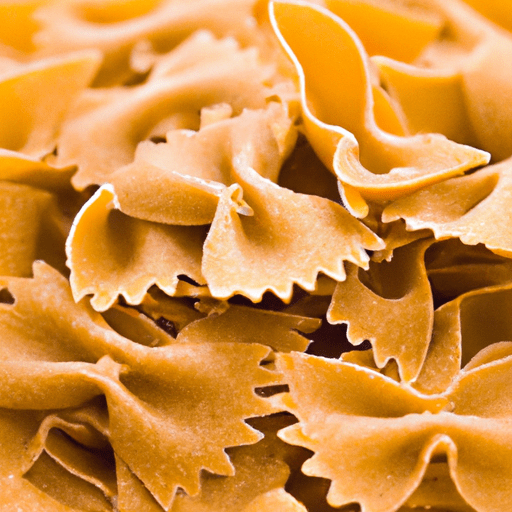The Delightful World of Cooked Whole Wheat Bowtie Pasta
Have you ever tried cooked whole wheat bowtie pasta? This adorable pasta shape, also known as farfalle, not only looks charming but adds a unique taste and texture to your favorite pasta dishes. In this blog post, we’ll dive into the world of cooked whole wheat bowtie pasta, exploring its delightful taste, common uses in cooking, nutritional value, and some interesting history and facts. So grab a seat and let’s dig in!
Taste and Texture
One bite into cooked whole wheat bowtie pasta, and you’ll immediately notice its delightful taste and texture. The nutty, earthy flavor of whole wheat adds a depth that complements a wide range of sauces and ingredients. The texture of bowtie pasta is equally remarkable. With its firm yet tender bite, it offers a satisfying chew that holds up well, even when paired with heavier sauces.
Common Uses in Cooking
Cooked whole wheat bowtie pasta is a fantastic addition to various culinary creations. Its versatile shape and robust flavor make it a perfect choice for both simple and elaborate dishes. Here are a few popular uses for cooked whole wheat bowtie pasta:
- Pasta Salads: The bowtie shape of this pasta lends itself beautifully to pasta salads. Toss it with fresh vegetables, herbs, and a tangy dressing for a refreshing and satisfying meal.
- Creamy Pasta Dishes: The nooks and crannies of bowtie pasta catch creamy sauces exceptionally well. Its firm texture helps it retain its shape, making it an ideal option for dishes like Alfredo or carbonara.
- Baked Pasta Dishes: Cooked whole wheat bowtie pasta shines in baked pasta dishes, such as casseroles and lasagnas. Its unique shape and flavor add an extra touch of elegance and interest to these comforting creations.
Nutritional Value
When it comes to nutritional value, cooked whole wheat bowtie pasta is a winner. Unlike refined pasta, whole wheat pasta retains the bran and germ, making it a great source of fiber, vitamins, and minerals. It offers a delightful combination of complex carbohydrates and essential nutrients, including iron, magnesium, and B vitamins. By incorporating cooked whole wheat bowtie pasta into your meals, you can enjoy a tasty dish while nourishing your body.
History and Fun Facts
While the precise origin of bowtie pasta remains unknown, it is undoubtedly one of the most playful shapes on the pasta shelf. The word “farfalle” means “butterflies” in Italian, which perfectly captures the whimsical appearance of this pasta. In regions like Lombardy and Emilia-Romagna in Italy, farfalle is known as “strichetti” or “little ribbons.” This pasta shape gained popularity during the 16th century and has since become a beloved choice in many cuisines worldwide.
Did you know that bowtie pasta also goes by the name “farfalloni” in Italian? The term “farfalloni” refers to larger-sized bowties, providing more room to capture and hold onto sauces.
Final Thoughts
Cooked whole wheat bowtie pasta brings a delightful combination of taste, texture, and versatility to your cooking adventures. From its nutty flavor to its ability to pair well with various ingredients, this pasta shape is a true winner. So, whether you’re preparing a vibrant pasta salad or a comforting baked dish, consider incorporating cooked whole wheat bowtie pasta into your culinary creations. It’s a simple yet delightful twist that will elevate your pasta experience to new heights.
Origin: Whole wheat bowtie pasta, also known as farfalle pasta, originated in the Lombardy and Emilia-Romagna regions of Northern Italy. The name “farfalle” derives from the Italian word for “butterflies,” as the pasta’s shape resembles small bowties or butterflies.
Common Uses: Cooked whole wheat bowtie pasta is a versatile ingredient that can be used in various dishes. It is commonly featured in pasta salads, soups, and as a base for creamy or tomato-based sauces. Whole wheat bowtie pasta’s unique shape and texture make it well-suited for holding chunky sauces or ingredients.
Nutritional Benefits: Whole wheat bowtie pasta is a good source of complex carbohydrates and dietary fiber. Compared to regular white pasta, it contains higher amounts of fiber, vitamins, minerals, and antioxidants. It also has a lower glycemic index, which means it raises blood sugar levels more slowly than refined grains.
Unique Properties: The shape and texture of cooked whole wheat bowtie pasta allows it to capture and hold onto sauces and ingredients, enabling a delightful combination of flavors in each bite. The ridged surface of the pasta provides a slightly chewy texture that complements various sauces. Additionally, due to its shape, it cooks evenly and retains its structural integrity.
Historical Significance: Pasta has been a staple in Italian cuisine for centuries, and the exact origins of bowtie-shaped pasta are uncertain. However, pasta shapes similar to farfalle have been documented as early as the 16th century. Over time, different regions in Italy developed their own variations, ultimately contributing to the diverse range of pasta shapes available today.




Use the share button below if you liked it.
It makes me smile, when I see it.